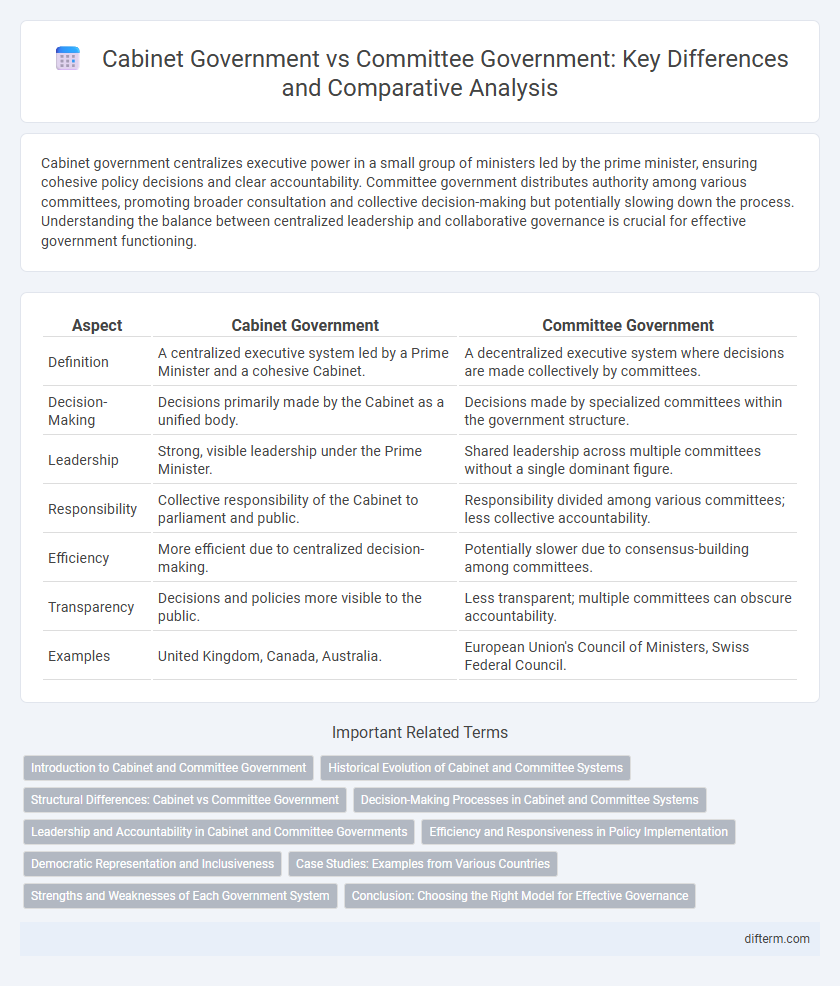Cabinet government centralizes executive power in a small group of ministers led by the prime minister, ensuring cohesive policy decisions and clear accountability. Committee government distributes authority among various committees, promoting broader consultation and collective decision-making but potentially slowing down the process. Understanding the balance between centralized leadership and collaborative governance is crucial for effective government functioning.
Table of Comparison
| Aspect | Cabinet Government | Committee Government |
|---|---|---|
| Definition | A centralized executive system led by a Prime Minister and a cohesive Cabinet. | A decentralized executive system where decisions are made collectively by committees. |
| Decision-Making | Decisions primarily made by the Cabinet as a unified body. | Decisions made by specialized committees within the government structure. |
| Leadership | Strong, visible leadership under the Prime Minister. | Shared leadership across multiple committees without a single dominant figure. |
| Responsibility | Collective responsibility of the Cabinet to parliament and public. | Responsibility divided among various committees; less collective accountability. |
| Efficiency | More efficient due to centralized decision-making. | Potentially slower due to consensus-building among committees. |
| Transparency | Decisions and policies more visible to the public. | Less transparent; multiple committees can obscure accountability. |
| Examples | United Kingdom, Canada, Australia. | European Union's Council of Ministers, Swiss Federal Council. |
Introduction to Cabinet and Committee Government
Cabinet government centers power in a small group of senior ministers led by the Prime Minister, making key decisions collectively while maintaining clear accountability. Committee government disperses decision-making across various specialized committees that include ministers and sometimes external experts, promoting detailed scrutiny and broader participation. Both models shape how executive authority is exercised within parliamentary systems, influencing policy coherence and government efficiency.
Historical Evolution of Cabinet and Committee Systems
The historical evolution of cabinet and committee government reflects shifts in political power and administrative efficiency, with cabinet systems emerging prominently in 18th-century Britain as monarchic authority waned and parliamentary governance expanded. Committee government developed parallelly or subsequently, emphasizing collective decision-making and detailed policy review, particularly in parliamentary democracies seeking to balance executive power. Over time, the cabinet government model centralized executive responsibility within a small group of ministers, while committee government underscored broader legislative engagement and specialization through standing and select committees.
Structural Differences: Cabinet vs Committee Government
Cabinet government features a collective decision-making body led by a Prime Minister, where all ministers share joint responsibility for policies and actions, emphasizing unified authority. Committee government disperses power across specialized committees, allowing ministers more autonomy within their domains but potentially leading to fragmented policy coordination. The structural distinction lies in centralized leadership in cabinet systems versus decentralized, committee-based governance, affecting policy coherence and ministerial accountability.
Decision-Making Processes in Cabinet and Committee Systems
Cabinet government centralizes decision-making authority within a unified executive body led by the Prime Minister, ensuring collective responsibility and coordinated policy implementation. In contrast, committee government distributes decision-making across specialized committees, fostering expertise-driven discussions but sometimes resulting in slower consensus-building. The cabinet system emphasizes hierarchy and political leadership, while committee systems prioritize detailed deliberation and consensus among diverse members.
Leadership and Accountability in Cabinet and Committee Governments
Leadership in cabinet government is typically centralized in a prime minister or president who holds significant authority over policy direction, whereas committee government diffuses leadership responsibilities across multiple committee members. Accountability in cabinet governments is clearer, with the cabinet collectively responsible to the legislature and electorate, enabling easier identification of decision-makers. Committee governments often face challenges in accountability due to shared leadership, which can obscure responsibility and complicate the democratic oversight process.
Efficiency and Responsiveness in Policy Implementation
Cabinet government typically enhances efficiency in policy implementation by centralizing decision-making authority within a cohesive executive team, enabling swift action and clear accountability. Committee government, involving multiple committees and broader stakeholder participation, can slow policy execution due to the need for consensus-building but may increase responsiveness to diverse interests. The trade-off between the streamlined efficiency of cabinet systems and the inclusive responsiveness of committee models significantly impacts governance outcomes.
Democratic Representation and Inclusiveness
Cabinet government centralizes decision-making within a select group of ministers, potentially limiting diverse representation and reducing inclusiveness in democratic processes. Committee government disperses authority across multiple committees, enhancing participatory governance by incorporating broader viewpoints and improving democratic representation. This structure fosters inclusiveness by allowing greater input from various political factions and interest groups within government.
Case Studies: Examples from Various Countries
Case studies of cabinet government reveal strong hierarchies in countries like the United Kingdom, where collective responsibility and the Prime Minister's leadership are emphasized. In contrast, committee government is evident in Switzerland, characterized by collegial decision-making within the Federal Council, promoting consensus among its seven members. Germany's hybrid model combines cabinet government principles with committee routines in the Bundesrat, balancing federal and state interests effectively.
Strengths and Weaknesses of Each Government System
Cabinet government centralizes executive power within a cohesive group of ministers led by the prime minister, promoting clear accountability and streamlined decision-making but may risk excessive concentration of authority and limited broader consultation. Committee government distributes power across multiple committees, enhancing inclusivity and diverse input, yet it can result in slower decision processes and potential difficulties in assigning responsibility. Understanding these strengths and weaknesses helps evaluate governance structures in parliamentary democracies.
Conclusion: Choosing the Right Model for Effective Governance
Cabinet government centralizes decision-making authority within a core group of ministers led by the prime minister, enabling coherent policy direction and accountability. Committee government distributes power across multiple committees, promoting inclusive deliberation and diverse input but potentially slowing decisions. Selecting the right governance model depends on balancing efficiency, representation, and the complexity of policy challenges to ensure responsive and effective government administration.
Cabinet government vs Committee government Infographic

 difterm.com
difterm.com